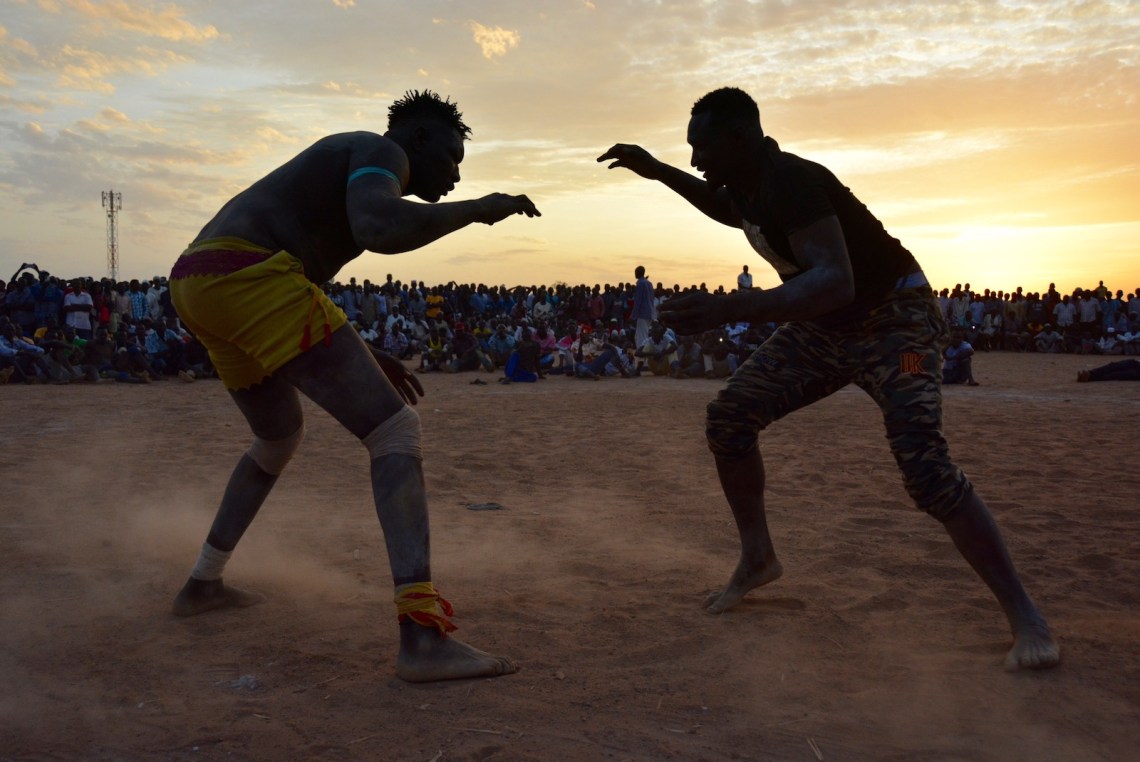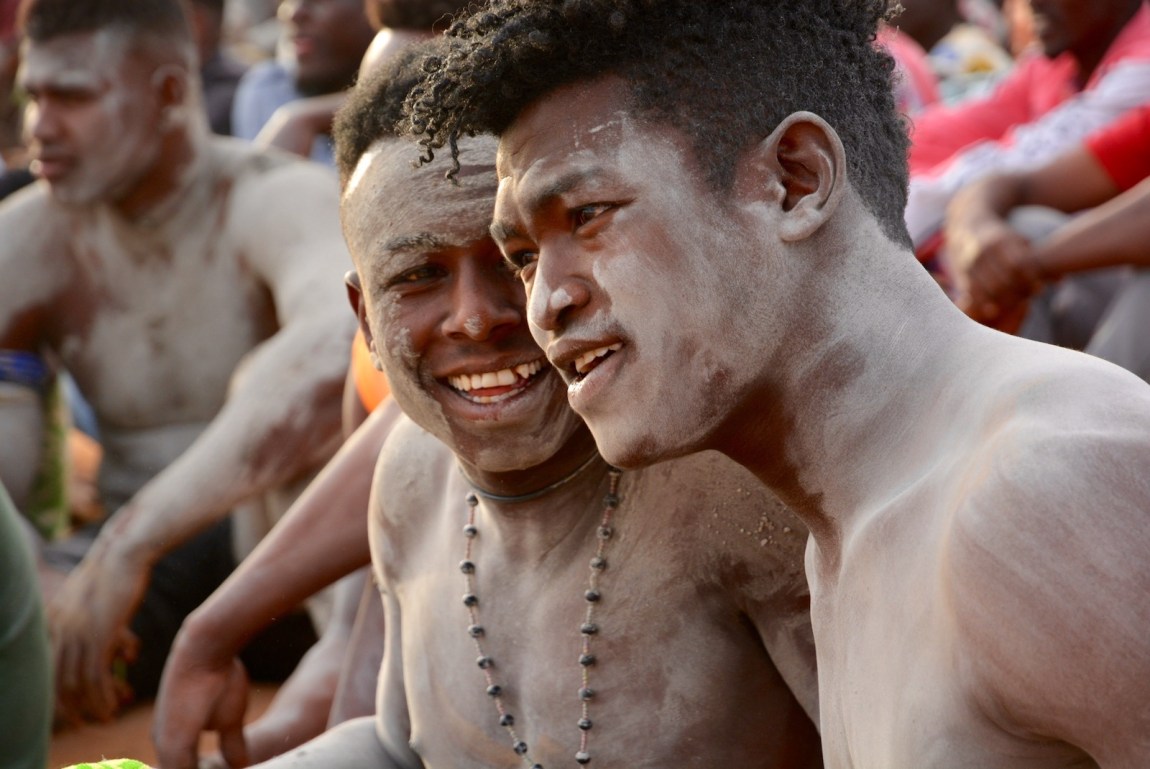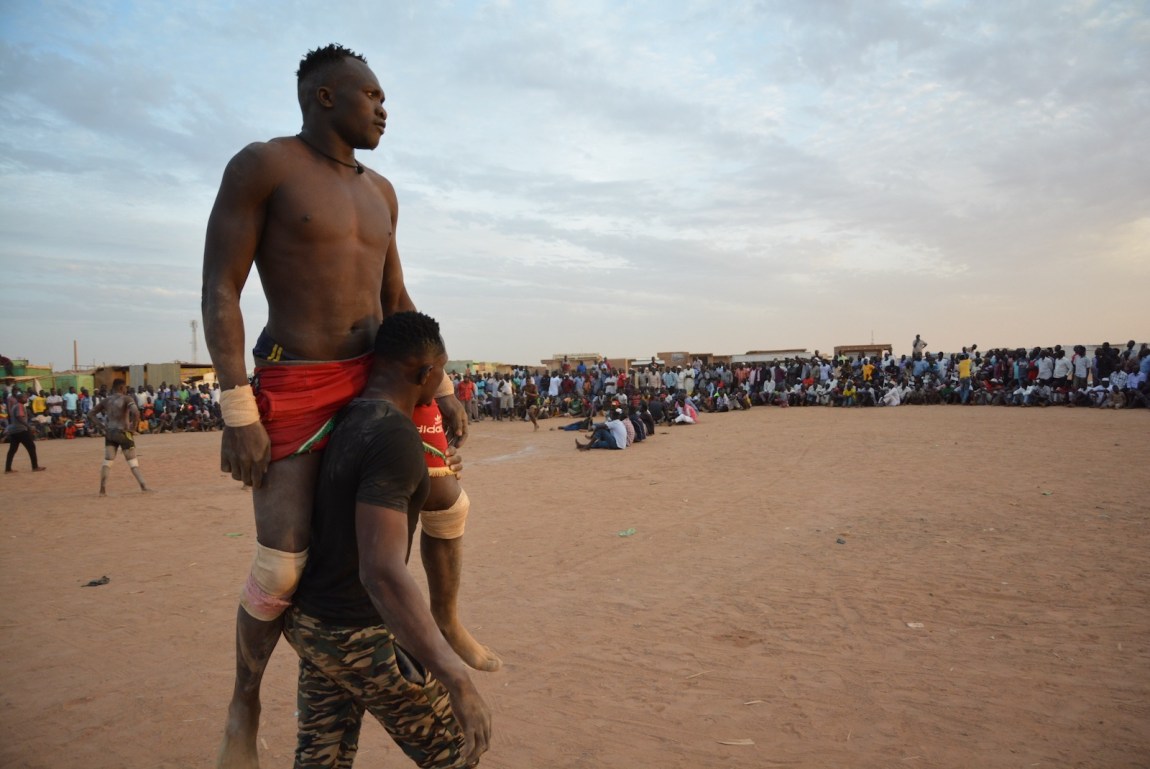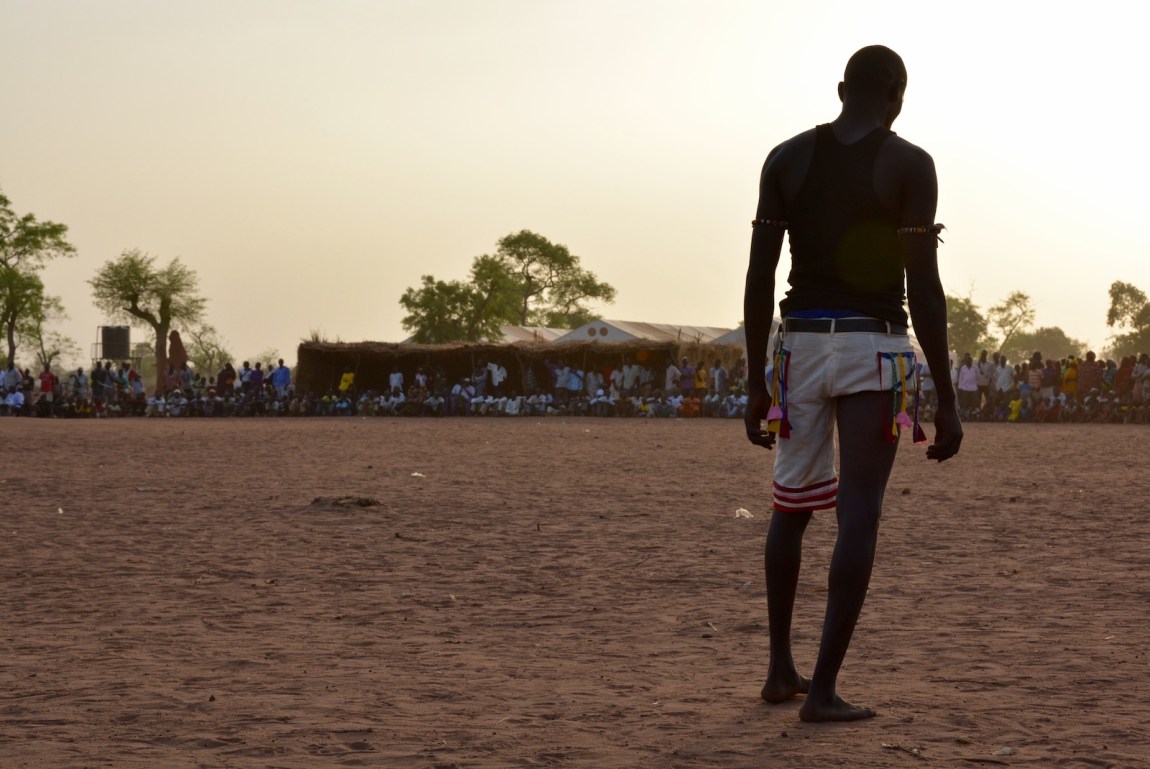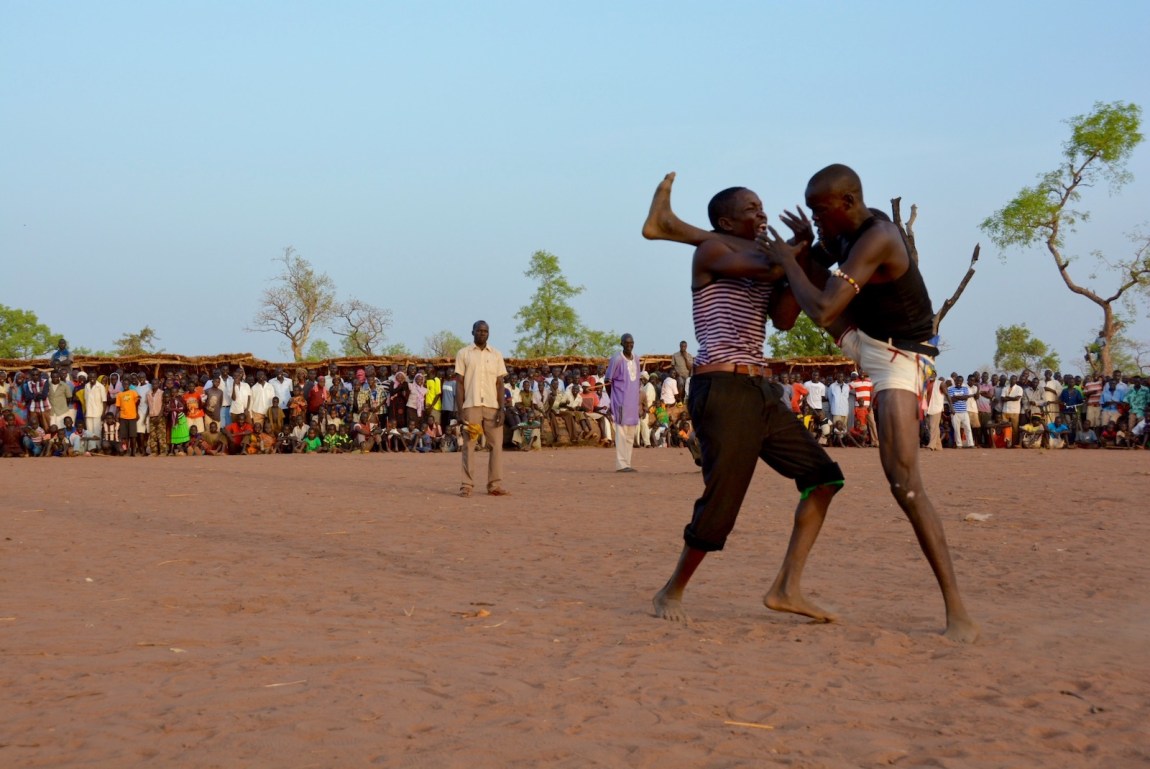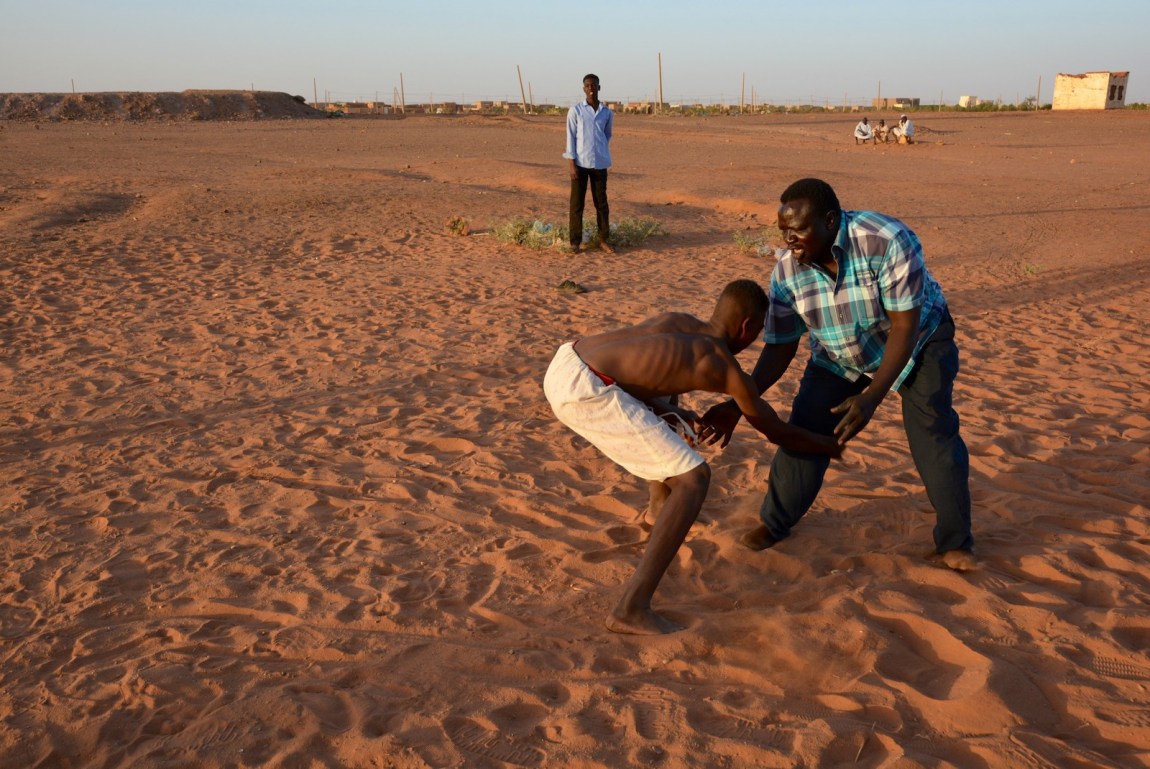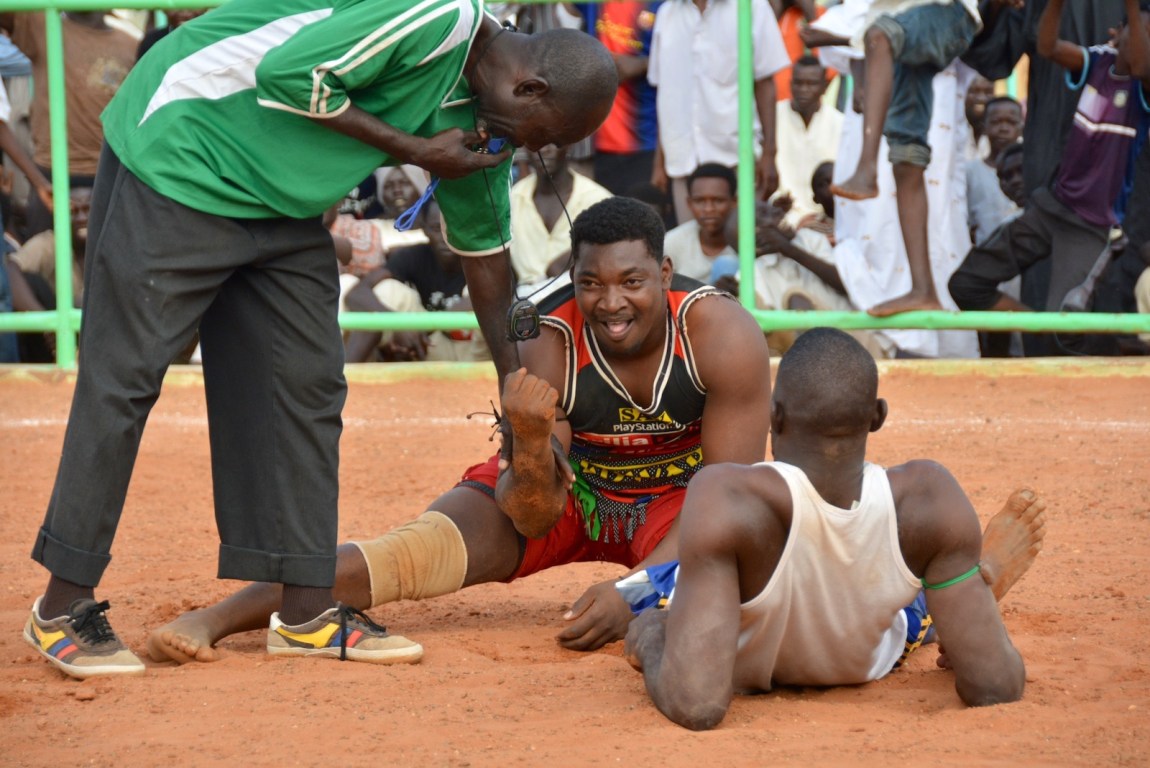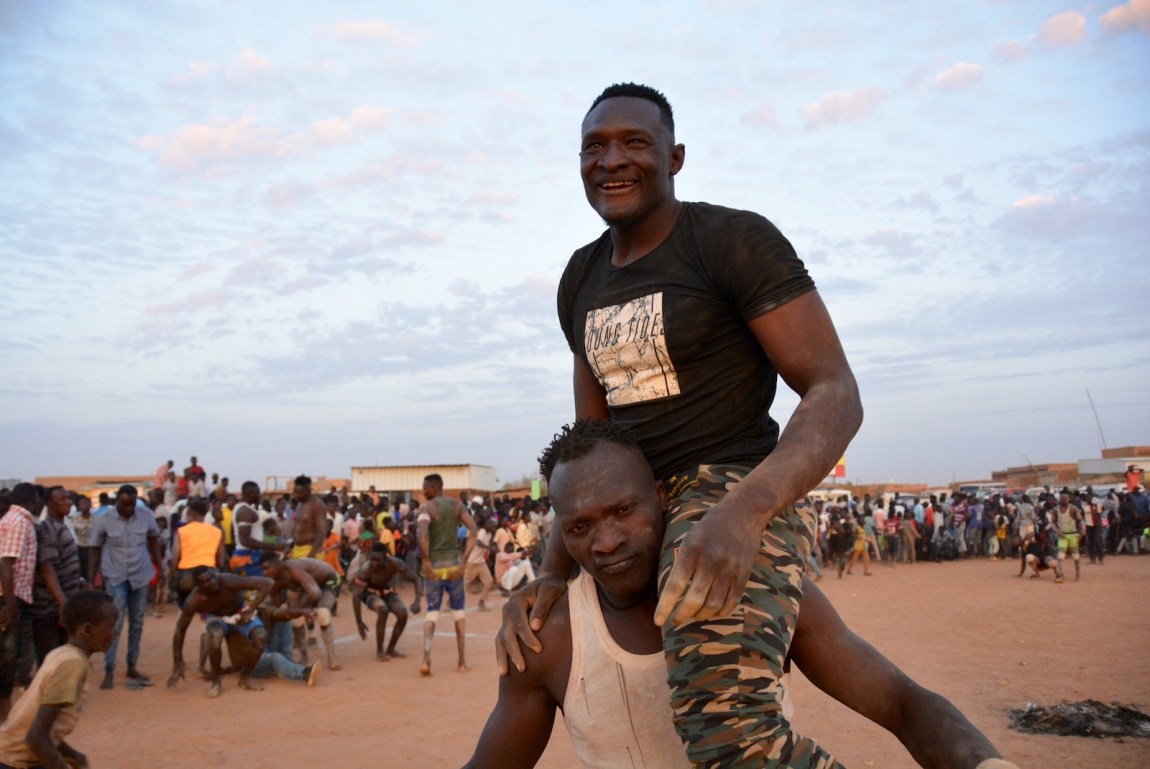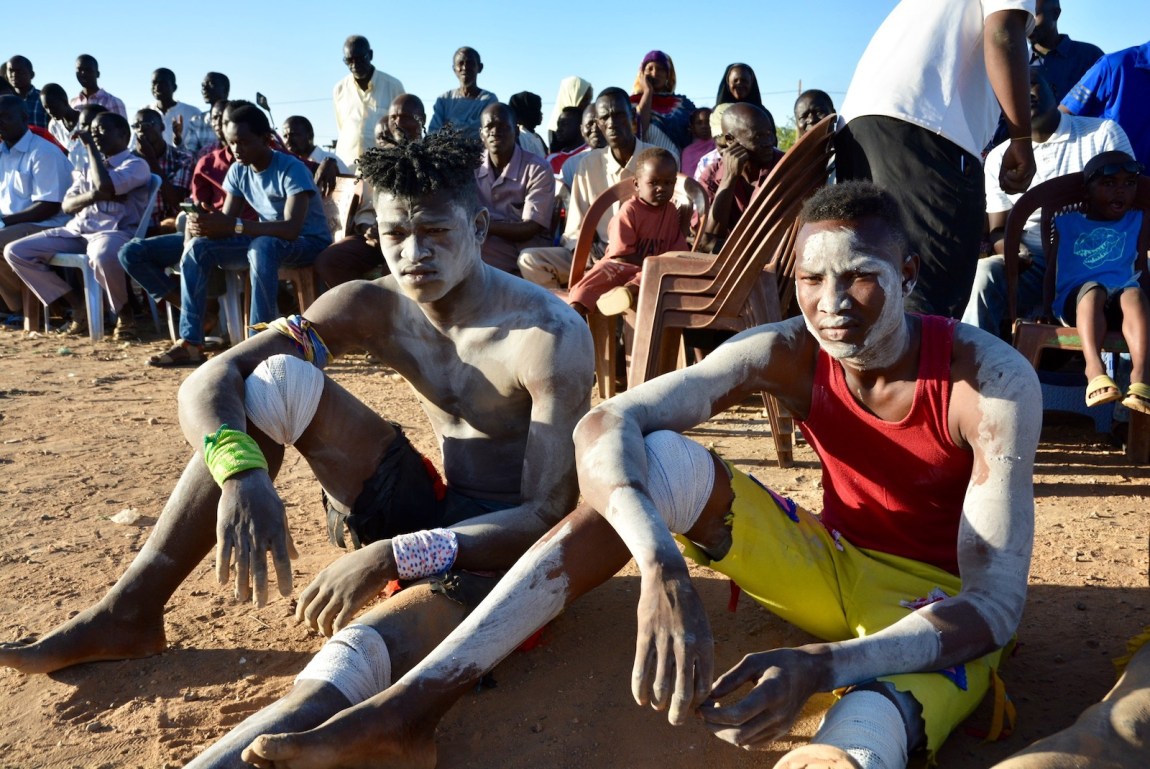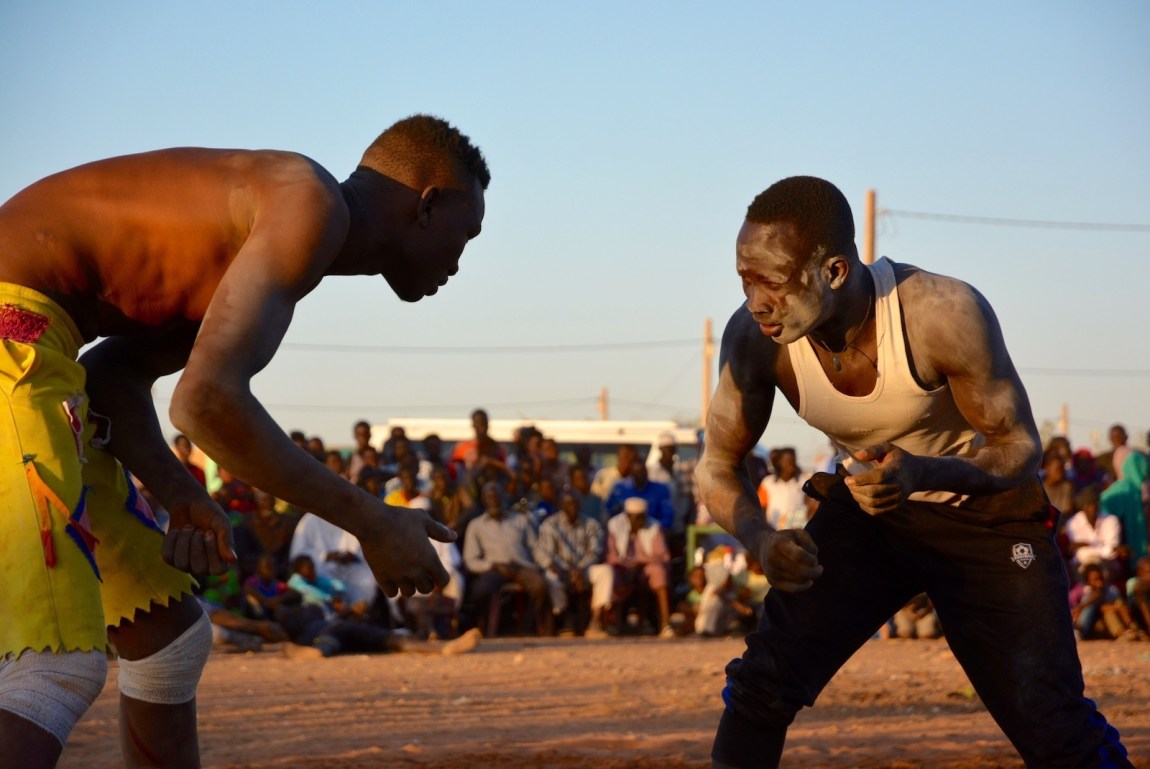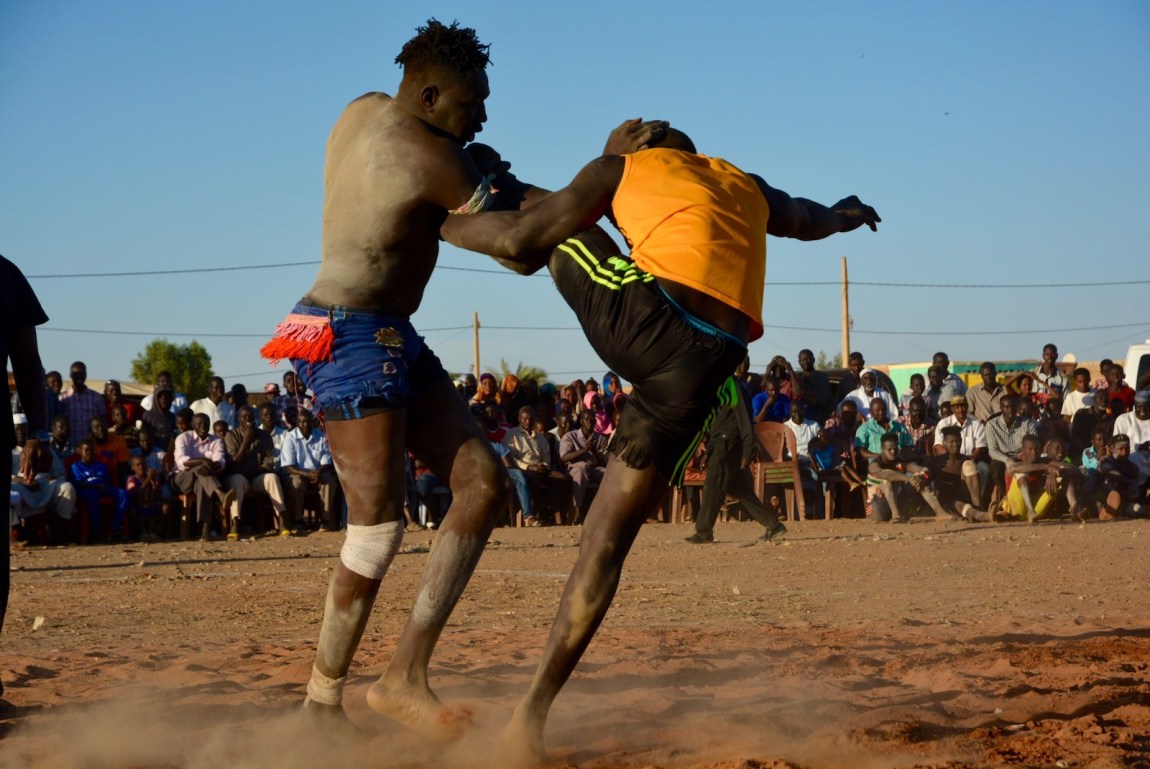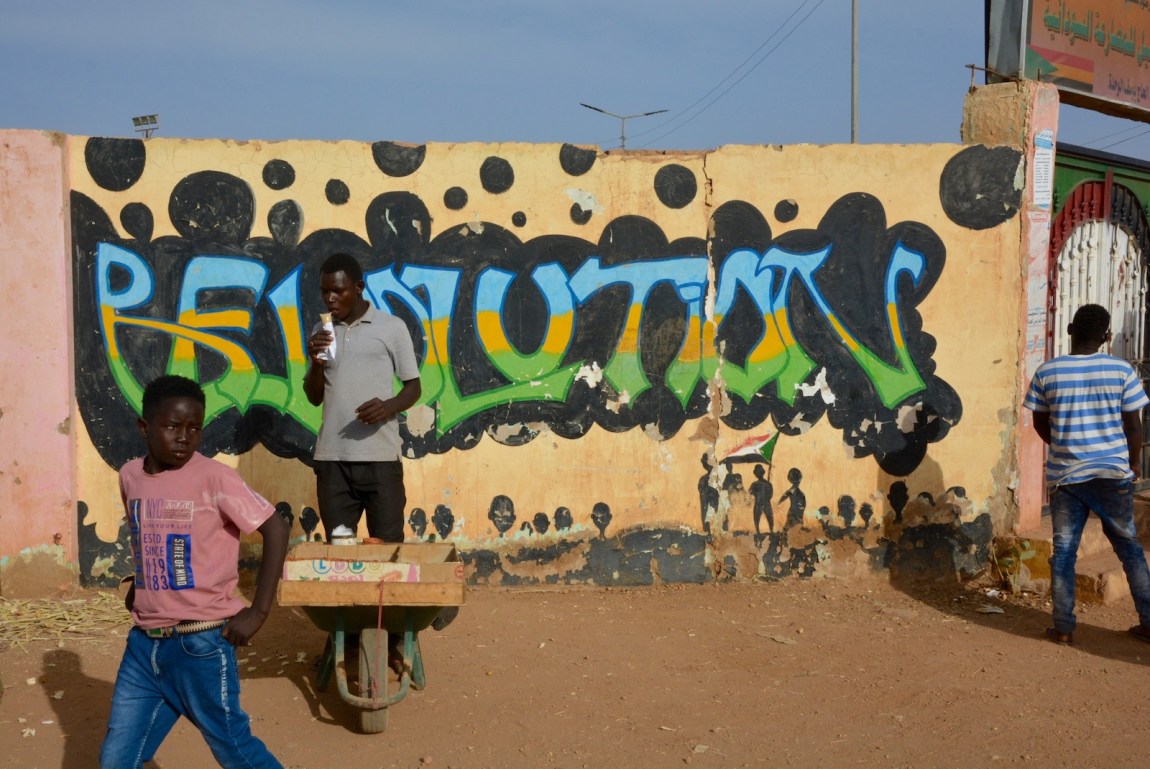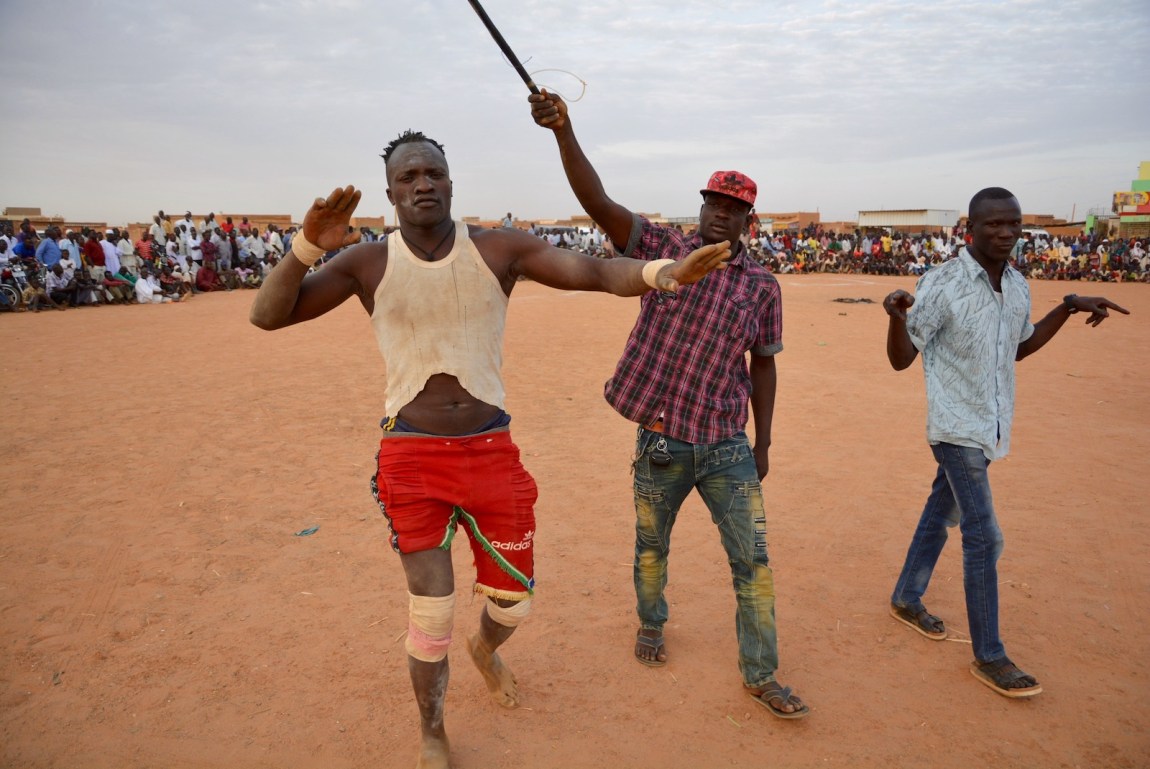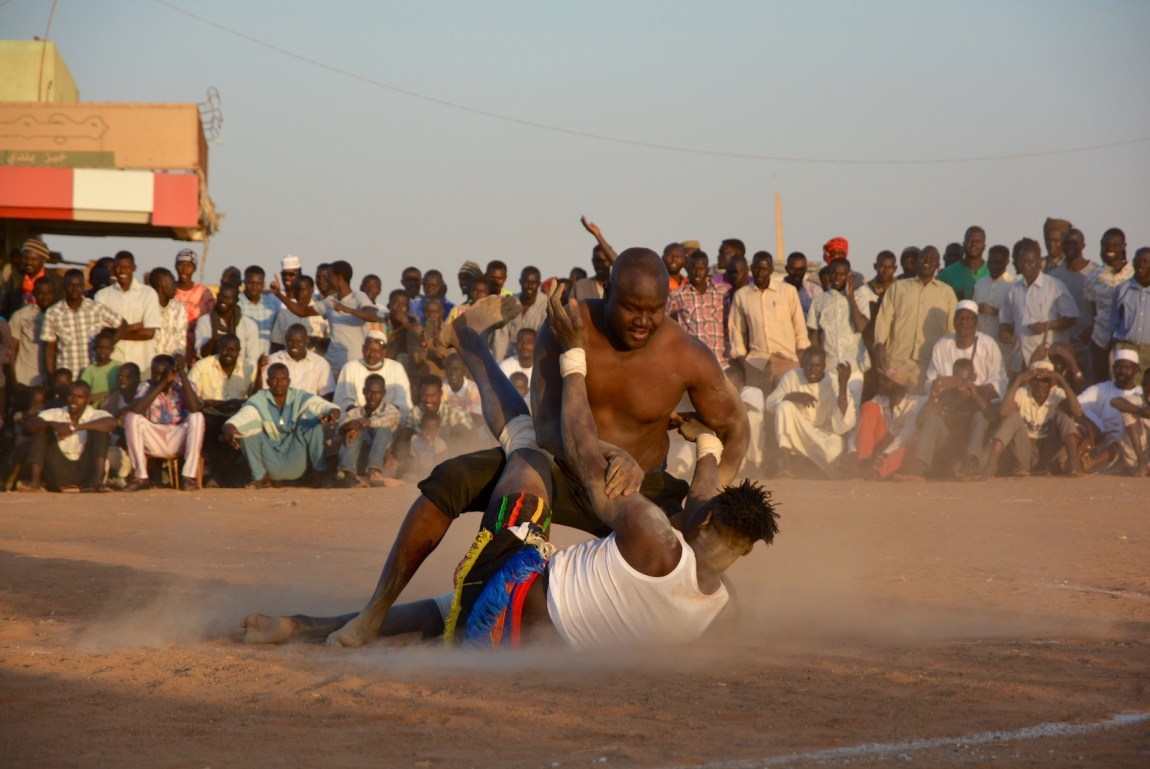1.
When I stay in Khartoum I never miss the weekly wrestling bouts in suburbs populated by Nuba and other communities displaced to the capital from Sudan’s war-torn peripheries. In less than a month here, too, there will be war—soldiers shooting with small and heavy guns, tanks shelling, planes bombing—for the first time in the city’s history. Everybody fears it, speaks about it, but also tries to forget it and enjoy the holiday. It’s a Friday evening, March 17, the start of the weekend in Muslim Sudan and time for the match. This week it takes place in a popular part of Omdurman, Khartoum’s twin city on the west bank of the Nile. It is the last round before Ramadan, during which wrestling is interrupted—and the last before the war, but hardly anyone imagines the clashes could begin so soon.
The wrestlers wear athletic shorts, some adorned with colorful fringes, embroidery, and decorative patterns. They have smeared their faces and bare torsos with ash—the only truly traditional wrestling dress, some say, and a protection against the evil eye. In small groups they enter the arena, a large circle of sandy ground ringed by spectators. The champions parade before their fans and raise arms or a leg in salute. Over loudspeakers installed for the occasion, the commentator chants their monikers—one could say their noms de guerre, since most refer to the violence that has for decades troubled many of their homelands. He invokes the ninety-nine peaks of the Nuba Mountains, in the remote southern province from which Nuba wrestling, and most of the wrestlers, originate.
The two sides of the arena each represent a neighborhood of Khartoum. Facing off against the wrestlers from Omdurman are those from Haj Yusif, in the district of Sharq al-Nil (east of the Nile), the river’s other bank. When two wrestlers agree to fight, they greet in the center of the ring, sometimes shaking hands. They size up and challenge each other with a light slap or a hand on the head. Suddenly, one attacks. They quickly come shoulder to shoulder, head to head. Each tries to get free of the other’s grip and grab his leg or arm. The first on the ground loses. A fight can last a few seconds or several minutes.
First to fight is Telga Matmuna (“precision shooting”), who defeats Dafe Rubay (“SUV”). A young wrestler who has just arrived in Khartoum, Zaaf (“ambulance” or “first aid”), wins his bout by lifting the leg of his opponent Karaba (“electricity”) until he loses his balance, an effective technique. Sometimes the winner grabs both legs and pushes his rival around like a wheelbarrow.
The more famous wrestlers advance. Kiri (“unauthorized”) challenges the opposing camp several times, but is refused for now. Another champion known as American Dog—slang for the grenade launchers used by the Sudanese army against Nuba rebels, which were believed to throw chemicals with paralyzing effects—wears jeans, a plaid shirt, and a baseball cap. He’s not fighting today, but parades with his friend Awilo and a veteran wrestler, all three from Omdurman, to challenge their Haj Yusif rivals.
Again Kiri tries to find an opponent. Karta (“goldmining spoils”) refuses him but accepts Awilo. The two of them bow to take sand from the ground, which they spread on their hands and bodies. Combined with the ash, the sand dries up sweat and makes it harder for wrestlers to grip each other. They grapple for a while without a clear victor, until the referee blows his whistle to declare a draw, after the requisite four or five minutes ring on his timer. Karta and American Dog threaten each other with glares and finger gestures. Kiri carries Awilo on his shoulders to an ovation from the crowd—standard practice after a good, victorious fight. Karta, lying on the ground, ignores them.
In a corner the wrestlers’ assistants count the banknotes thrown at their champions—fans try to stick them on their sweaty foreheads—and collect them in a large plastic bag. The sun is setting when Karta finally accepts Kiri. Another long fight. Karta loses his balance and finds himself with one knee on the ground, then two. But still he resists. Again the referee calls a draw, but Kiri claims the victory and rides on Awilo’s shoulders. A good fight often ends with the loser carrying the victor, and sometimes vice-versa. Had Karta’s defeat been recognized he would have carried Kiri, then Kiri could have carried him.
The bellicose looks and gestures are already forgotten. They were part of the show—as are the wrestlers’ theatrical monikers, which refer not only to the most murderous weapons used in Sudan’s wars but also to the various armed forces and militias involved in them. There are wrestlers nicknamed “Janjaweed” (the Arab militias recruited by the government to fight in Darfur), “al-Difa al-Shabi” (Popular Defense, an earlier paramilitary force fighting in southern Sudan and the Nuba Mountains), “Abu Tera” (a later paramilitary police called the Central Reserve, now under US government sanctions), and “al-Dam al-Sari” (after the Rapid Support Forces, or RSF, the latest and most powerful paramilitary force). Many wrestlers also belong to these forces, some to the army, others to the RSF. But no one talks about that tonight, nor do they guess they will soon be fighting each other. For now the crowd cheers, kids invade the ring and wrestle in imitation of the champions, and the square quickly empties at the sunset call to prayer.
Advertisement
2.
Wrestling has been a favored pastime in the Nuba Mountains for as long as anyone can remember. Contemporary Nuba often date it back to the second millennium BCE, when Nubian pharaohs ruled over northern Sudan (as they later would over Egypt), the source both of the name “Nuba” and of some Nuba languages. The scattered rocky hills of Sudan’s South Kordofan state are believed to have long served as a refuge for about a hundred distinct communities, each with its own language and homeland, some limited to as small an area as a single village. By Arabic-speaking outsiders, those diverse people have been collectively called “Nuba.” Kids begin wrestling as early as seven, the same age at which they start working as shepherds of the family’s livestock. The best are selected by their village or tribe and fed better, more copious meals until they become champions—who in Nuba wrestling are called faris, or knights—and represent the tribe in competitions around the mountains.
Nuba wrestling became known in the West from the work of two photographers. Whenever I see the final carrying ritual at a wrestling match I remember a powerful vertical, black-and-white image by the British photojournalist George Rodger showing a champion sitting on the shoulders of his defeated opponent, both seemingly looking at the camera. Rodger covered the Allied victory against Nazi Germany—he was among the photographers who entered Bergen-Belsen—and in 1947 cofounded Magnum Photos. His time photographing the Nuba was the culmination of a long journey he took through Africa to heal from his war traumas, and his pictures show him trying to look clearly at the life in front of his eyes.
His picture of the two wrestlers is often mistakenly attributed to another photographer it inspired. At sixty, in 1962, Leni Riefenstahl, Hitler’s unrepentant friend and favorite filmmaker, began a series of photographic trips to the Nuba Mountains in a clear attempt to leave behind her Nazi past. This was only a partial success, so obvious seemed the continuity between her Nazi sport iconography and her obsessive focus on muscular, naked Nuba men and women as emblems of bodily purity and physical strength. Given its own contempt for the Nuba, it is hardly surprising that the central government in Khartoum made Riefenstahl the first foreigner to receive Sudanese citizenship.
Riefenstahl declined to acknowledge, as Susan Sontag pointed out in these pages, that by the time she took her last trips to the mountains in the 1970s the Nuba were already suffering as a result, notably, of “the civil war that has been tearing up that part of Sudan for a dozen years.” Khartoum’s cultural assault on the Nuba included prohibiting undressed people to enter towns or trade with merchants, in effect banning the nakedness Riefenstahl prized. It only got worse in the next decade. In 1986 the Sudan People’s Liberation Movement (SPLM), a rebel group formed two years before in southern Sudan, began to recruit Nuba and establish camps in the mountains. Successive governments in Khartoum responded with an all-out counterinsurgency against Nuba civilians, dropping devastating barrel bombs from Soviet-made Antonov cargo planes. They justified their war in the name of Sudan’s Arab identity, and after a coup which brought the Islamists to power in 1989 they called it a jihad, although the Nuba are both Muslim and Christian, in addition to remnants of their traditional faiths. Like the war that began in Darfur in 2003, the conflict in the Nuba Mountains during the late 1980s and early 1990s has widely been recognized as genocide.
Nuba culture, seen as primitive and essentially neither Arab nor Muslim, was targeted in what the Islamists called their “civilization project.” During the 1990s thousands of Nuba were forced by the government into so-called peace camps where they were to be properly Arabized and Islamized. Thousands of others fled to Khartoum’s shanty suburbs. The veteran wrestler Yasir “Port Sudan,” forty-four, remembers that he was kicked out of primary school for speaking Mandel, his Nuba mother tongue. The Arabization policy even touched names. “My official name, Mubarak Abderrahman, is Arabic,” a Nuba politician told me. “But actually my real name, my Nuba name, is Ardol Anuwa.” He is known locally as Mubarak Ardol.1
Advertisement
“Wrestling,” Ardol says, “is related to peace, to times of good harvest and satisfaction, with no hunger.” For those who remained in the mountains, the war hampered the sport. The bombings obliged people to hide in caves or foxholes, and along with landmines made it perilous to travel to compete. Still, bouts could sometimes take place during the rainy season, the traditional time for harvest festivals, when rich milk gave the wrestlers strength and the frequent cloud cover hindered the Antonovs.
In 2002 a ceasefire followed by a peace agreement gave the SPLM large shares of power over the region and allowed wrestling to resume. The Nuba rebels, in an attempt to revive traditions, encouraged it. When the war restarted in 2011, about 70,000 Nuba civilians fled to a refugee camp called Yida, just south of the world’s newest border, in newly independent South Sudan. The country’s rulers, the southern wing of the SPLM, still supported their former comrades in the Nuba Mountains against Khartoum, and the camp was a perfect rear base for the rebels, now renamed the SPLM-North.
It was also a meeting point for members of different Nuba tribes. In a vast square in the middle of the camp, amid white tents and huge red termite nests, lively wrestling games took place every Wednesday, the Nuba’s customary day off. I saw a match there in 2013. It was preceded by dances performed by tribal representatives, each proudly displaying their community’s trademark accessory: thin sticks for the Shatt, cattle horns tied on the head for the Miri. The brief bout was followed by more dances, involving most of the spectators.
Some wrestlers in Yida were said to be rebel fighters, but not many, because the SPLM-North didn’t want to deprive the community of popular champions. According to Ardol, then an SPLM-North leader often based in Yida, the market day in rebel areas had become Wednesday, “when everyone drank local beer.” The SPLM-North strongman Abdelaziz al-Hilu made recognition of the Wednesday holiday instead of Muslim Friday or Christian Sunday part of the agenda of his negotiations with the government, in which he demanded state secularism and respect for indigenous culture. “Abdelaziz is looking for liberation in a radical sense—from holy days to the whole government system,” Ardol told me.
Before South Sudan’s secession, Sudan’s dictator, Omar al-Bashir, had warned that there would be “no time to speak of cultural and ethnic diversity” if the South obtained independence. What would remain of Sudan, he was suggesting, would have no room for cultures other than Arab and Islamic ones. But wrestlers who fought in Yida were still going to Khartoum to become famous, including a few SPLM-North soldiers who would hide their rebel affiliation. “Those wrestlers in Yida,” Ardol said, “are not faris like those in Khartoum.”
3.
In 2013 I attended a match in Khartoum for the first time. It was in the recently built, green-painted concrete stadium in Haj Yusif, for a crowd of mostly Nuba, who then reportedly accounted for a fifth of the city’s population of five million (it is six million today). War-related displacement, Ardol told me, had turned Haj Yusif into “a little Jebel Nuba, and the regime couldn’t oppose the traditions.”
When Yasir “Port Sudan” arrived in Khartoum in 2000, the sport was called “Nuba wrestling.” The next year the city’s Nuba community chose to rename it “Sudanese wrestling,” concluding that people in the capital would look down on anything that bore their name. Sudanese wrestling attracted more and more devotees and would-be wrestlers from Khartoum’s mixed suburbs. “Now the majority of the wrestlers are Arabs, and they’ve defeated Nuba many times,” Yasir told me this past March in a fish restaurant before the usual Friday evening match at the Haj Yusif stadium, where many young Arab wrestlers tried their luck. “When there’s a dispute, we Nuba tell them, ‘this is our wrestling.’” I noticed that Nuba wrestlers got nervous when their Arab rivals boasted in front of me.
Yasir told me that he naturally became a wrestler, just like everyone born in the Nuba Mountains. There “your family and all the village will take care of you and bring you food, because you represent them and are their hero, their faris. Everyone took care of me, sang for me.” He might have remained a local champion if he hadn’t had a crush on a girl of his tribe. When she moved with her divorced mother to Port Sudan, the country’s harbor on the Red Sea, he followed and courted her until he won her hand. On his way home, in 2000, he stopped in Haj Yusif and wrestled. There was no stadium then, only an empty space near the market walled off by a canvas fence to ensure that spectators bought tickets. Yasir won twice, and because he had come in the dress of Port Sudan, a black sleeveless vest over a white jalabiya, he got the nickname he has had ever since. In 2006 he and fellow champions traveled to Niger for a show, which was hosted in a stadium. Once back they requested a stadium in Haj Yusif. The government approved it.
One might have expected that the Islamist junta would have banned Nuba cultural activities, but after the 2005 Comprehensive Peace Agreement between the government and the SPLM, both sides began to compete for support in Khartoum’s suburbs. The Islamists had largely failed to enforce their civilization project in the slums, where forbidden activities such as drinking alcohol continued unbothered. Now the regime pretended to adopt a multicultural agenda, and it likely saw wrestling as a way both to calm restive suburbs and to steer their residents into joining the army and the ruling party rather than the rebels. Yasir told me that the government not only tolerated but encouraged the wrestling because it “wanted to get the support from the Nuba.” The stadium in Haj Yusif was also used at times for political gatherings for the ruling party, for instance ahead of the 2015 election, likely rigged, in which al Bashir won another term with 94 percent of the vote.
Wrestling in Khartoum differs from its counterpart in the Nuba Mountains. There one knee or hand on the ground means defeat, which often makes the bouts faster and avoids draws, while in Khartoum the loser must be fully lying on the sand. In the Muslim capital wrestling stops with the sunset prayer, while in the mountains it often used to take place in the light of the full moon. Khartoum wrestling is not “pure,” as Riefenstahl would have put it, but syncretic. The Nuba wrestlers, whose strength seems to have survived their exile to the capital of an oppressive state, are no longer naked but dressed in soccer jerseys and other colorful tight sportswear supplied by wrestling clubs. While in the mountains the community feeds its wrestlers to give them strength, in the city they’re on their own. “There the food is healthy, organic, you feel strong,” a champion known as “Don’t Seat” told me. “In Khartoum, if you don’t have family, sometimes you don’t eat for two days and you have to work, and after work you’re tired.”
For the wrestlers, success doesn’t mean money. The revenue from ticket sales at the gate of the stadium is said to vanish into the pockets of the organizers, while too many wrestlers have to share the banknotes thrown by the crowd. No champion seems to have become wealthy. “In Khartoum, you can’t live from wrestling, as there’s no tribe to take care of you, only clubs,” Yasir says. “Most wrestlers work in the military. Nuba just joined government forces for money.” Yasir didn’t join. He worked in road construction, then sold motorbikes and cars at the Haj Yusif market.
In 2013 I photographed a bout between two champions known as Majros and Influenza. (The latter took his name from the 2009–2010 H1N1 epidemics. More recently there was a wrestler nicknamed Corona.) My Darfuri friend Sherif, who had never seen a fight, chatted with aficionados in the crowd and told me that neither of these fighters was Nuba. Both were Arabs from the Hawazma tribe, the Nuba’s longtime enemies in the lowlands around their mountains, who long ago adopted Nuba traditions, including wrestling. Since the 1980s, Hawazma troops have constituted the core of the Popular Defense Forces (PDF), militias recruited locally to fight the Nuba rebels. Majros, whose nickname came from the huge German “Magirus” trucks the army was using to transport troops, was a member of the PDF. Influenza had at that point been recruited into the regular army.
In fact, Sherif told me, most of the strongest wrestlers, including Nuba champions, were soldiers or militiamen. The government in Khartoum had enlisted Nuba in its army as early as British colonial times, and later in its militias to fight their brothers in the mountains as well as other non-Arabs in Darfur. The Sudanese, recalling the slave armies of precolonial times, have a motto for this paradigm of warfare: “the slave against the slave.” A well-known joke represents the Sudanese army as a Coca-Cola bottle: its contents, symbolizing the foot soldiers, are black, while the cap, the officers, is red—the color attributed to the Arabs from Sudan’s center, who have dominated the military, with its grip on both politics and the economy, since the country’s independence in 1956. “The only job for Nuba in Khartoum is joining the army or police,” Ardol told me. The kirang, a Nuba dance in which participants frantically stomp their right feet, has been adopted into the military’s official morale-boosting parades. By some accounts, half of the army’s rank-and-file could be Nuba.
4.
My 2013 stay in Khartoum ended after a month, when I learned I was on the regime’s blacklist. I only returned to Sudan in 2020, the year after the fall of al-Bashir, when I got a new visa and came back to find a fresh generation of wrestlers. My friend Mudawi Hassan, an occasional wrestling commentator, introduced me to some of the current champions, including Kiri, twenty-nine, one of the most popular Nuba faris.
“Wrestling is a kind of happiness that God brought to poor people,” Kiri told me as we drank tea outside the stadium after the bout, under the stars. His moniker, which means “unauthorized” or “unchecked,” is usually used in reference to unweighed, unsafe meat sold in Khartoum’s streets; he inherited it from his father, himself a wrestler in the Nuba Mountains. But Kiri was born in Haj Yusif, a city kid who used to watch wrestling and fight other children in the ring after the match. He began working at the local market, shining shoes, cleaning cars, and selling plastic bags. Then he became a construction worker and a mechanic’s assistant, wrestling in his downtime. When he reached nineteen he stopped working and “focused on the stadium.” According to him, his best fight was in 2017, when he beat Majros “with a very good technique” known as dara, spinning or flipping: he grabbed one of his opponent’s arms, then put one of his legs between Majros’s legs to trip him, while putting his other hand on the ground to avoid falling himself. An enthusiastic Mudawi recalled, “It was the end of Majros’s career, a shame for him, then he disappeared!”
In 2015, like his father before him, Kiri was recruited by the army’s sport department, another institution aimed at strengthening the troops’ morale and popularity. It needs athletes for its own competitions, including one of which the Sudanese army seems particularly fond: tug of war. Kiri joined as a private and was promoted to first class, which was enough for his ambition. He was hoping to be deployed to Yemen, where since that year Khartoum had been sending thousands of troops to fight in the Saudi-led coalition against the Huthi rebels. The wages there were said to be higher than in Sudan.
So were the risks. In 2021 the Hawazma Arab wrestler “John Cena” was killed at the Yemeni-Saudi border. He was not in the army but in the RSF, which was formed in 2013 as an enhanced version of the janjaweed militias recruited the previous decade among the Arab communities of Darfur. By 2017 the RSF had become al-Bashir’s praetorian guard, under his direct authority, as a protection against a possible coup by frustrated officers from the army. The two forces competed to recruit their rank and file from the country’s peripheries. There were tribal affinities: the Nuba tended to join the army, while the Arabs preferred the RSF.
Five days after meeting Kiri, I sat again under the stars in Haj Yusif (electricity is sparse outside downtown Khartoum) with Karta, his twenty-two-year-old cousin Zaaf, and their Nuba friend Angola. We drank medide, milk with millet, a wrestler’s staple, served by a woman of the neighborhood. Zaaf, the youngest and most talkative of the three, had only arrived in Khartoum a week ago and had just fought in the capital for the first time the day before. He had to borrow Karta’s shorts. I had seen him challenge two Nuba wrestlers, defeat one, and lose to the other. He seemed happy with that result: “Congratulations to me!” he boasted.
Zaaf belongs to a well-known Hawazma Arab family of eight brothers, including Influenza and another wrestler named al-Rubaya (“anti-aircraft gun”). Among wrestlers it’s customary to quit the sport, temporarily or for good, after marrying; when one of Zaaf’s brothers would get married, the next-oldest would rise to represent the family in the ring. Wrestlers in training are made to swear off sex to avoid losing energy and are often kept in isolated huts where they’re fed “the five foods which make you a strong wrestler: meat, milk, dates, millet, and sesame,” Zaaf tells me. They’ll be watched and coached by old wrestlers, fighting with them until they get out of breath, running, doing “pull-ups, push-ups, and abs until you don’t have belly.” He had to suffer this regimen for four months:
I had no choice, they forced me, but they fed me well. When the watchmen left, they locked the door and the phone was not allowed…. If you don’t obey, they’ll beat you up. When you’ll go to the toilets, one of them will cock his gun, in case you try to run.
In 1998, as Nuba rebels attacked their area, Zaaf’s elder brother Dar Hamid decided to fight alongside the army and was killed. “It seems wrestlers are the first to be shot during battles,” Zaaf said. “We believe when you become a famous wrestler, it brings you evil eye. But war didn’t stop the wrestling. We fight today, we’ll wrestle tomorrow.”
The first Nuba wrestler said to have joined the RSF, in 2019, was Shiriya (“evilish”), who had already fought in government militias and was a known cattle raider. He sided with the tribe of his Arab mother and recruited younger Arab wrestlers as bodyguards. Among them were Zaaf—who told me he joined both “to serve the country” and because he wanted to fight, although there was then no war—and his brothers Influenza and Obama. The latter, who had become a faris during Obama’s presidency, was killed in 2020 in a clash between Arab RSF and Nuba army troops in Kadugli, the capital of the Nuba Mountains. It was arguably the first battle between the army and the RSF. “The family felt the loss of Obama,” Zaaf said. “We were sad, but it was war.”
Sitting in Haj Yusif, Zaaf compared experiences with Karta, who had refused to join the army, and Angola, who enlisted. “In the army,” Angola said, “there’s no freedom, the rules are tough, while the RSF is a militia. Your officer can give you three or four months’ leave. But if you die, you have no rights, no compensation money for your family. The army is better.” Zaaf said that the RSF had given him “three months’ leave to wrestle, to become more famous. If we win, the RSF will congratulate us and give us money.”
Then, mezza voce, Karta and Zaaf began to sing wrestling songs, which are also love songs:
I’m very lovesick
And that disease can kill,
Better take me to the doctor
Before the young wrestler defeats me.
5.
In April 2019, as street protests challenged al-Bashir’s regime, Hemetti, the leader of the RSF, agreed with army officers to topple the aging dictator. But the protests continued after the coup that overthrew al-Bashir. Calling for a transition to civilian democratic rule, they morphed into a sit-in in front of the armed forces’ headquarters.
That was Mudawi’s day. The son of a bus driver in Haj Yusif who died when Mudawi was three, he had the same street vendor’s childhood as Kiri, watching wrestling after working at the market. “When you saw wrestling once, you become an addict,” he told me. He became an unofficial, vibrant commentator. He had long been frustrated with the regime’s control over the stadium; Paul Hayes’s excellent documentary Lions of Khartoum: Sudan’s Wrestlers After a Revolution (2020) shows Mudawi chanting the revolutionary slogan “freedom, peace, and justice” at the mic.
Mudawi took some twenty wrestlers to the sit-in, some of whom were in the RSF or the army, and organized a match in solidarity. “All wrestlers supported the revolution,” Kiri, who wrestled then, assured me. “Most people from downtown Khartoum had never seen wrestling before!” Yasir organized the show with Mudawi and wrestled himself. Those who didn’t join were not necessarily against the revolution. “I was afraid to be shot,” Karta confessed.
On June 3 the RSF and other military forces opened fire on the protesters, killing at least 128. That day an occasional wrestler called al-Wasila was reportedly erecting a barricade with stones in Haj Yusif. When RSF soldiers came to open the street, he began to box them. They shot him and hid his body in the gutter. He was deemed a martyr, and his portrait was painted on the stadium alongside other revolutionary murals. The regime had tried to coopt the Nuba champions, but when the revolution came the wrestlers nevertheless saw themselves among the poor against the elite.
Yet politicians still courted them. In August 2019 Mubarak Ardol, tired of exile, splintered from the already fragmented SPLM-North to return to Khartoum on his own. When he announced his own political party, the Democratic Alliance for Social Justice, in a Chinese-built government conference center known as Friendship Hall, a dozen wrestlers, including Yasir “Port Sudan” and Kiri, were there. One of them carried Ardol on his shoulders like a faris.
The transitional authorities needed Nuba leaders, and Ardol was appointed director of the strategic Sudanese Mineral Resources Company. But he grew frustrated with the domination that political leaders from Khartoum exercised over the government’s civilian wing, and in time he grew closer to Lieutenant-General Shamseddin Kabbashi, the deputy commander-in-chief of the armed forces and one of the army’s very few Nuba officers. In October 2021, when the army and the RSF jointly toppled the civilian government, Ardol supported the coup. He became a favorite target of the civilian political parties.
The Nuba are so scarcely represented among the political and military leadership that many appear to support Ardol or Kabbashi just because they are kinsmen and disliked by the elite. In February 2022 a wrestling bout held in Ardol’s honor divided the residents of Haj Yusif. Anti-coup protesters called a demonstration on social media, but other residents wanted to see the wrestling. At the end of the match Ardol poured ashes on American Dog, who had fought well, and made a speech promoting his party that riled his detractors. Yasir and other wrestlers had to escort him back to his car. “People don’t even know my political program,” he told me when we met later in his villa, in the area then inhabited by the government’s highest officials. “They support me as Nuba. In Sudan, tribe and color matter.” He gave the wrestlers money and sportswear.
Yasir, who had helped organize the event, showed Mudawi and me pictures of himself lying in bed among banknotes. Still in a revolutionary mood, Mudawi half-jokingly shamed him for having betrayed the Nuba people. Yasir responded that he had to spend three quarters of the money to make the bout happen. “We don’t care that Ardol supported the coup,” he added. “We support him as a Nuba.”
6.
“All politicians use the wrestlers for political reasons, but at least Ardol is Nuba,” another wrestler, Kerubino, told me when we met in a Paris café this past June. He had wrestled that day last year in front of Ardol, against American Dog. I had seen him a week before then in Omdurman, in a bout organized to celebrate his return to Sudan after eight years of exile in Europe. First he defeated a South Sudanese wrestler known as Salva Kiir (after the South Sudanese president). Then American Dog defeated him.
Kerubino, who is about forty, is the nephew of Kuku Jaz, once an amateur wrestler and now a famous SPLM-North brigadier general. He grew up in the Nuba Mountains, herding the family’s cattle with other kids, all of them wrestling, even the girls. He was among the children identified as future champions, and in 2007 he became a local faris. On a trip to Khartoum that same year, to accompany a relative to the hospital, he attended a match in Omdurman as a spectator. The crowd recognized him and pushed him into the ring. He won ten fights.
The Lion’s Heart Club in Haj Yusif wanted to recruit him. He told them that he had to take care of his cows, but that when they needed him they could send a messenger. (There was no mobile network in the mountains then.) A month later, after two days of traveling by bus, the messenger arrived. Kuku Jaz, one of the few SPLM-North leaders who never went to the capital, authorized Kerubino to leave. “Take care,” he said. “Khartoum is not safe!”
For six years, Kerubino traveled back and forth between the capital and the mountains. Then, in 2013, a first round of demonstrations in Khartoum was heavily repressed. More than 170 protesters were killed. Kerubino was arrested by the Intelligence Service on the allegation that he had robbed a bank, but it turned out the agents were trying to recruit him to spy on his rebel uncle. A friend managed to vouch for him and advised him to leave Sudan. He sold some cows, moved to Egypt, then Turkey, then crossed the Aegean Sea to Greece. He spent two years in Germany, where he found the people too racist, then moved to France. There he worked in construction, without papers until he got his resident permit in 2020. He trained in asbestos removal, a line of work much in demand in France.
But even as his situation improved he felt homesick and decided to return to Sudan for good. “There’s more money to be made in the Nuba Mountains than in Khartoum or even in France,” he told me. “I and my family have many cows and good farms, and our area is rich with gold.” In December 2021 he landed in Khartoum. He wrestled three times. He was still in shape; in Paris he had kept training with three other exiled wrestlers.
Before wrestling for Ardol, Kerubino was his bodyguard in Paris, where the then–rebel leader came for peace talks. When they met again in Khartoum, though Ardol didn’t say anything explicit, the way he spoke made Kerubino feel that war was coming. He flew back to France. “The life I live here is not the life I decided to live,” he told me. “But at least there is peace.”
On April 15, war broke out between the army and the RSF. Since then Kerubino has received only limited news from his wrestling colleagues. They have fought on both sides in Khartoum—Zaaf with the RSF, as he had hoped, American Dog with the army. Kerubino is in touch with two others in the army, and he urges them to defect rather than die for nothing. Some have already done so. Majros left the army, but to join his Arab mates in the RSF, and Angola went back to the Nuba Mountains after surviving heavy casualties in the defense of the army headquarters. Back home he was killed by an Arab RSF fighter, not in battle but in a romantic dispute. His fellow wrestlers mourned him on social media. On the RSF side, a wrestler known as “Revolutionary Front” was killed in battle.
Mudawi took refuge in Ethiopia. In a message this past May, he told me that some wrestlers in the army were injured. “Others, we don’t know if they’re dead or alive.” He said all the Arab wrestlers had joined the RSF, even the once-reluctant Karta, who had been promised money to become “a big leader in Haj Yusif” and recruit others. Later, pictures circulated of Karta with the rank of a RSF brigadier general, the same rank Hemetti got when he was chosen to head the paramilitary force in 2013. In one Influenza and him pose in uniform; in another he holds a teddy bear likely looted from a wealthy house. “It’s very bad for us now coz all the wrestlers are [either] in the RSF or the army,” Mudawi wrote. “We don’t know who to support. It’s very bad in Haj Yusif. There’s no light.”


